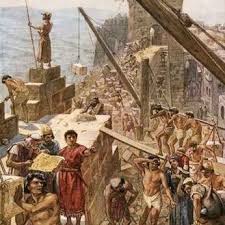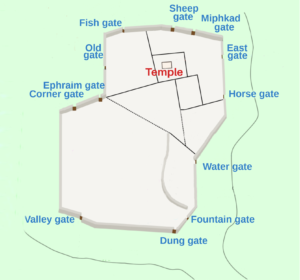The Construction of the Eastern Wall
Nehemiah 3: 15-32
DIG: Nehemiah’s name is conspicuous by its absence from this chapter. What do you suppose he was doing while all the others were “doing their work?”
REFLECT: How can you tackle some project at your messianic synagogue or church that is not finished as a result of a lack of volunteers?
445 BC During the ministry of Nehemiah (to see link click Bt – The Third Return).
Compiled by: The Chronicler from the Ezra and Nehemiah Memoirs
(see Ac – Ezra-Nehemiah from a Jewish Perspective: The Nehemiah Memoirs).
The style of this section of Nehemiah is somewhat different than the previous file (see Bz – Repairing the Northern, Western and Southern Walls). The most evident difference is that the landmarks are now primarily houses and other buildings instead of gates. The reason for this is probably that the east side of the City did not follow the old wall but was built farther up on the crest of the hill along the eastern side of Jerusalem.230

Construction of the South-East Wall: Shallun son of Col-hozeh, the ruler of the district of Mizpah, repaired the Fountain Gate, which may also be translated the Spring Gate. He built it, covered it, and set up its doors, its bolts, and its bars. He also repaired the wall of the Pool of Shelah by the King’s Garden, as far as the stairs going down a steep ascent south-east from the City of David (Nehemiah 3:15). Probably to be identified with Shiloah (Isaiah 8:6), or Siloam. Water from the Pool of Siloam flowed through the King’s Garden located outside the walls where the Kidron and Hinnom valley converge (Second Kings 25:4).
Beyond him Nehemiah son of Azbuk, the ruler of half the district of Beth-zur, an important town on the southern border (Joshua 15:58), about thirteen miles south of Jerusalem and marked the southern limits of the province of Judah. It was turned into a fortress by Rehoboam (Second Chronicles 11:7). There, Nehemiah son of Azbuk, made repairs as far as the tombs of David (Second Chronicles 32:33) and the artificial pool constructed by Hezekiah, or the Kings Pool (2:14), and the House of the Warriors (Nehemiah 3:16). This was the site of the royal barracks that David erected for his body-guard described (see the commentary on the Life of David Ej – David’s Mighty Warriors).

After him, the Levites made repairs under Rehum son of Bani, and beside him, Hashabiah, the ruler of half the district of Keilah (Joshua 15:44; First Samuel 23:1), about fifteen miles south-east of Jerusalem, made repairs for his district (Nehemiah 3:17). After him repairs were made on the high priest’s house by their brothers in the other half of the district under Binnui son of Henadad, the ruler of half the district of Keilah. On one side of the house the Levites built a wall. Adjacent to him Ezer son of Jeshua, the ruler of the city of Mizpah, repaired another section in addition to the section repaired by the men of Mizpah (Nehemiah 3:7), opposite the ascent to the armory at the corner buttress where part of the wall turns inward (Second Chronicles 26:9). Strategically it was one of the most important points in the fortifications (Nehemiah 3:17-19).
The residences of the high priest and his colleagues were located along the eastern wall of the City, corresponding with the retaining wall of the Temple area above the Kidron Valley. After him Baruch son of Zaccai zealously repaired another section from the corner buttress up to the door of the house of Eliashib, the cohen gadol. After him Meremoth son of Uriah, son of Hakkoz, repaired another section (he had already repaired a section in Nehemiah 3:4) from the door of the house of Eliashib to the end of the house of Eliashib. And after him the cohanim worked, men from the area surrounding Jerusalem (Nehemiah 3:20-22).
After them Benjamin and Hasshub made repairs in front of their house. After them Azariah son of Maaseiah, son of Ananiah, worked beside his house. Beyond him Binnui son of Henadad repaired another section from the house of Azariah up to the inner buttress and the corner where part of the wall turns inward. Palal son of Uzai made repairs opposite the inner buttress and the tower coming out from the upper palace of the king, which is by the court of the guard. Like Solomon’s palace, it would have had a guardhouse (Jeremiah 32:2). After him Pedaiah son of Parosh and the Temple servants living on the Ophel made repairs up to the area opposite the Water Gate toward the east of Jerusalem and the projecting tower, where the people assembled. After him the men of Tekoa also repaired another section from opposite the great projecting tower, one of the defenses on the eastern side of the Temple, to the wall of the Ophel (Nehemiah 3:23-27). The section described is from the Tower to the point where the west wall on the Temple mount had been repaired by Shallun in Nehemiah 3:15.

Construction of the North-East Wall: The residences of the priests were on higher ground above the Horse Gate where the cohanim worked, each in front of his own house (Jeremiah 31:39; Second Chronicles 23:15). The reference in Jeremiah has the information that it was in the east section of Jerusalem overlooking the Kidron Valley. It opened into the south-east of the Temple courts. After them Zadok son of Immer made repairs opposite his house and after him Shemaiah son of Shecaniah, the guard of the East Gate (the entrance to the Temple area on the eastern side), made repairs. As a keeper of the East Gate he must have been a Levite. After him Hananiah, son of Shelemiah, and Hanun, the sixth son of Zalaph, repaired another portion (Nehemiah 3:28-29).
There were chambers or rooms in the Temple construction as indicated by Ezra 10:6 and Nehemiah 12:44. Tobiah’s family was related by marriage to Meshullam (Nehemiah 6:18), who even gave Tobiah the Ammonite (Nehemiah 2:10) the use of one of those rooms (Nehemiah 13:4-9). After him Meshullam son of Berechiah made repairs in front of his living quarters. After him Malchijah, one of the goldsmiths, made repairs up to the house of the Temple servants (see An – Priests, Levites and Temple Servants Who Returned with Zerubbabel: Temple servants returning), and the merchants opposite the Inspection Gate and as far as the room above the corner. Between the room above the corner and the Sheep Gate, the goldsmiths and the merchants worked (Nehemiah 3:30-32). Having traveled around Jerusalem in a counter-clockwise direction, the narrative ends where it began.
This chapter also contains important teaching for believers today. One reason the work progressed was that everyone took part, from rulers to Temple personnel to merchants and citizens with their families (First Corinthians 12:4-13, 27-30). Even the people from the villages who lived a distance from Yerushalayim also helped. They felt part of the community, even though they personally received fewer direct benefits. Their cooperation on the walls is one of the finest pictures of Israelite brotherhood in the TaNaKh (John 17:21-23; First Thessalonians 1:7-8; Second Corinthians 8:3-5 and 9:1-2). Even their families were amazed at the results (notice the same in Acts 2:43-47 and 4:32). In order not only to survive but also to be effective in the midst of opposition from a hostile secular culture, the Church must exhibit a cooperative spirit. Another reason for the Jews’ success was Nehemiah’s wise delegation of labor. He knew how to choose leaders and to delegate authority (Second Timothy 2:2). Also, many built the part nearest their own house. A leader must take into account family and incentive factors in planning and delegating responsibilities (Ephesians 4:11-13).231



Leave A Comment